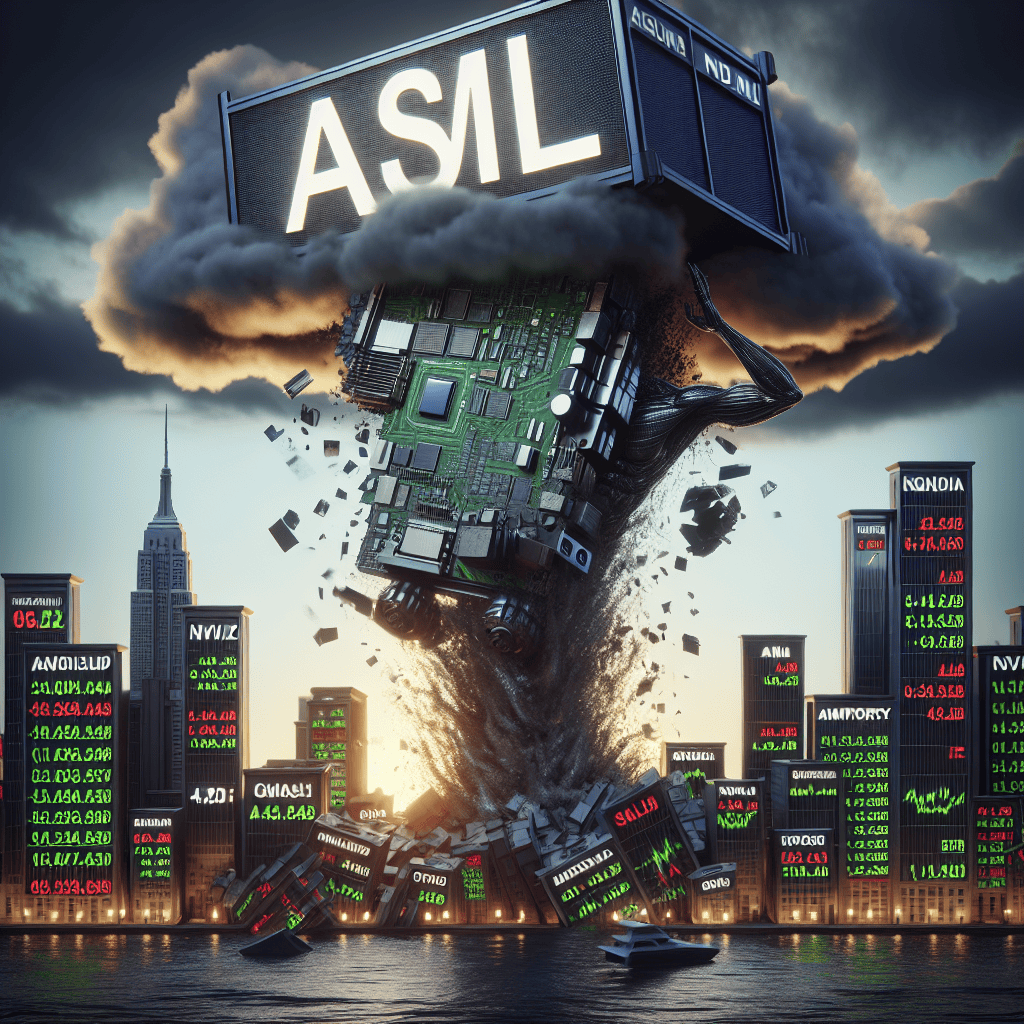“ASML’s Q3 Tumble: A Ripple Effect on Tech Titans.”
Introduction
ASML Holding NV, a leading player in the semiconductor equipment industry, experienced a significant downturn following the release of its third-quarter financial report. The company’s stock plummeted as investors reacted to the earnings announcement, which fell short of market expectations. This decline in ASML’s stock had a ripple effect across the technology sector, notably impacting shares of major companies like Nvidia and other semiconductor-related stocks. The disappointing results from ASML, a critical supplier of advanced lithography machines used in chip manufacturing, raised concerns about the broader semiconductor market’s health and future growth prospects, leading to a cautious sentiment among investors.
Impact Of ASML’s Q3 Report On The Semiconductor Industry
The recent release of ASML Holding’s third-quarter report has sent ripples through the semiconductor industry, causing a notable downturn in the stock market. ASML, a pivotal player in the semiconductor equipment sector, reported results that fell short of market expectations, leading to a significant drop in its stock value. This decline has not only affected ASML but has also had a cascading effect on other major players in the semiconductor industry, including Nvidia and several other technology stocks.
ASML’s role in the semiconductor industry is crucial, as it is the leading supplier of photolithography machines used in the production of advanced microchips. These machines are essential for the manufacturing processes of companies like Nvidia, which rely on cutting-edge technology to produce high-performance graphics processing units (GPUs) and other semiconductor products. Therefore, any fluctuations in ASML’s performance can have far-reaching implications for the entire industry.
The third-quarter report from ASML highlighted several challenges that the company is currently facing. Among these are supply chain disruptions and a slowdown in demand from key markets. These issues have contributed to a weaker-than-expected financial performance, which has, in turn, led to a decrease in investor confidence. As a result, ASML’s stock experienced a sharp decline, pulling down the stocks of other semiconductor companies that are closely linked to its fortunes.
Nvidia, a major customer of ASML, was particularly affected by this development. The company’s stock also saw a decline as investors reacted to the news. Nvidia’s reliance on ASML’s technology for its chip production means that any negative news regarding ASML can have a direct impact on Nvidia’s market performance. This interdependence highlights the intricate connections within the semiconductor industry, where the performance of one company can significantly influence others.
Moreover, the impact of ASML’s report extends beyond Nvidia. Other semiconductor companies, including those involved in the production of memory chips and processors, also experienced stock declines. This widespread effect underscores the importance of ASML’s role in the industry and the potential vulnerabilities that arise from such dependencies. The semiconductor sector is characterized by its complex supply chains and the need for continuous innovation, making it susceptible to disruptions in any part of the chain.
In addition to the immediate market reactions, ASML’s report has prompted broader concerns about the future outlook of the semiconductor industry. The challenges faced by ASML, such as supply chain issues and fluctuating demand, are not isolated incidents but rather indicative of larger trends affecting the industry. As companies navigate these challenges, there is an increased focus on strategies to mitigate risks and ensure stability in production and supply.
In conclusion, ASML’s third-quarter report has had a significant impact on the semiconductor industry, affecting not only its own stock but also those of major companies like Nvidia. The report has highlighted the interconnected nature of the industry and the potential vulnerabilities that can arise from such dependencies. As the industry continues to evolve, companies will need to adapt to changing market conditions and address the challenges posed by supply chain disruptions and demand fluctuations. The developments surrounding ASML serve as a reminder of the dynamic and often unpredictable nature of the semiconductor sector, emphasizing the need for resilience and strategic planning in navigating its complexities.
Analyzing The Market Reaction To ASML’s Earnings Miss
The recent financial disclosure by ASML, a leading player in the semiconductor equipment industry, has sent ripples through the stock market, affecting not only its own valuation but also impacting other major technology stocks, including Nvidia. ASML’s third-quarter earnings report fell short of market expectations, leading to a significant drop in its stock price. This unexpected earnings miss has raised concerns among investors about the broader implications for the semiconductor sector, which has been a critical driver of technological advancement and economic growth.
ASML, renowned for its advanced lithography machines essential for producing cutting-edge microchips, reported lower-than-anticipated revenue and profit figures for the third quarter. The company’s management attributed this shortfall to a combination of supply chain disruptions and a slowdown in demand from key customers. These factors have been exacerbated by ongoing geopolitical tensions and economic uncertainties, which have collectively contributed to a more challenging operating environment for ASML and its peers.
The immediate market reaction to ASML’s earnings miss was a sharp decline in its stock price, reflecting investor disappointment and recalibrated expectations for future growth. This decline was not isolated to ASML alone; it had a cascading effect on other technology stocks, particularly those with significant exposure to the semiconductor industry. Nvidia, a major player in the graphics processing unit (GPU) market, experienced a notable drop in its stock value as investors reassessed the potential impact of ASML’s performance on its supply chain and production capabilities.
The interconnectedness of the semiconductor industry means that a setback for one major player can have far-reaching consequences for others. ASML’s lithography machines are critical for the production of advanced chips used in a wide range of applications, from consumer electronics to artificial intelligence and data centers. Consequently, any disruption in ASML’s operations or financial performance can lead to concerns about potential delays or cost increases for companies reliant on its technology.
Moreover, the broader market sentiment has been affected by ASML’s earnings report, as investors become increasingly cautious about the semiconductor sector’s near-term prospects. The industry has been grappling with a series of challenges, including supply chain bottlenecks, fluctuating demand patterns, and geopolitical tensions, all of which have contributed to heightened volatility in stock prices. ASML’s earnings miss has served as a stark reminder of these challenges, prompting investors to reevaluate their positions and risk exposure in the technology sector.
In addition to Nvidia, other semiconductor-related stocks also experienced downward pressure following ASML’s report. Companies involved in chip design, manufacturing, and equipment supply chains saw their stock prices decline as market participants weighed the potential implications of ASML’s performance on their operations. This broad-based reaction underscores the sensitivity of the semiconductor industry to shifts in market dynamics and the importance of closely monitoring developments within this critical sector.
In conclusion, ASML’s third-quarter earnings miss has had a significant impact on the stock market, highlighting the interconnected nature of the semiconductor industry and the broader technology sector. As investors digest the implications of ASML’s performance, there is likely to be increased scrutiny on the company’s future guidance and strategic initiatives aimed at navigating the current challenges. The ripple effect on other technology stocks, including Nvidia, underscores the need for market participants to remain vigilant and adaptable in the face of evolving market conditions.
How ASML’s Performance Affects Nvidia And Other Tech Stocks
ASML Holding, a pivotal player in the semiconductor equipment industry, recently experienced a significant downturn following its third-quarter earnings report, which sent ripples across the technology sector, notably affecting companies like Nvidia. ASML’s performance is often seen as a bellwether for the broader semiconductor industry due to its critical role in supplying advanced lithography machines essential for chip manufacturing. Consequently, any fluctuations in ASML’s financial health or market outlook can have far-reaching implications for other tech stocks, particularly those heavily reliant on semiconductor technology.
The recent decline in ASML’s stock was primarily attributed to a combination of factors, including a cautious outlook for the coming quarters and concerns over potential slowdowns in demand. This cautious stance has raised alarms among investors, who are now questioning the robustness of the semiconductor industry’s growth trajectory. As ASML’s fortunes are closely tied to the capital expenditure plans of major chipmakers, any indication of reduced spending or delayed projects can lead to a reassessment of growth prospects for the entire sector.
Nvidia, a leading designer of graphics processing units (GPUs) and a major player in the artificial intelligence and gaming markets, is one of the companies most directly impacted by ASML’s performance. Nvidia’s reliance on cutting-edge semiconductor technology means that any disruptions in the supply chain or delays in the availability of advanced manufacturing equipment can have a direct impact on its product development timelines and market competitiveness. As a result, Nvidia’s stock often reacts sensitively to news concerning ASML, reflecting investor sentiment about the potential for future growth and innovation.
Moreover, the interconnected nature of the technology sector means that ASML’s performance can also influence other companies that are part of the semiconductor supply chain. Firms involved in the production of memory chips, processors, and other essential components may experience similar stock market volatility as investors reassess their growth prospects in light of ASML’s outlook. This interconnectedness underscores the importance of ASML’s role in the industry and highlights how its financial health can serve as a barometer for the broader tech market.
In addition to Nvidia, other tech giants such as Intel, AMD, and TSMC are also affected by ASML’s market performance. These companies, which are integral to the production and innovation of semiconductor technologies, rely on ASML’s equipment to maintain their competitive edge. Any potential delays or reductions in ASML’s production capabilities can lead to a ripple effect, impacting their ability to meet market demands and innovate at the pace required to stay ahead in the competitive tech landscape.
Furthermore, the broader implications of ASML’s performance extend beyond individual companies to influence investor sentiment across the technology sector. A downturn in ASML’s stock can lead to a broader market sell-off, as investors become wary of potential headwinds facing the semiconductor industry. This can result in a reevaluation of investment strategies, with some investors opting to reduce their exposure to tech stocks amid concerns over future growth prospects.
In conclusion, ASML’s recent stock market performance serves as a critical indicator for the semiconductor industry and the technology sector at large. Its influence on companies like Nvidia and others underscores the interconnectedness of the tech ecosystem and highlights the importance of closely monitoring ASML’s financial health and market outlook. As the industry continues to navigate challenges and opportunities, ASML’s role as a chip-gear giant remains pivotal in shaping the future trajectory of tech stocks.
The Role Of ASML In The Global Chip Supply Chain

ASML Holding NV, a pivotal player in the global semiconductor industry, recently experienced a significant downturn following its third-quarter financial report, which sent ripples across the stock market, affecting major technology companies like Nvidia. To understand the broader implications of this event, it is essential to delve into ASML’s critical role within the global chip supply chain and how its performance can influence the entire technology sector.
ASML, a Dutch company, is renowned for its advanced photolithography machines, which are indispensable in the production of semiconductor chips. These machines are used to etch intricate patterns onto silicon wafers, a fundamental step in chip manufacturing. ASML’s technology, particularly its extreme ultraviolet (EUV) lithography systems, is at the forefront of enabling the production of smaller, more powerful, and energy-efficient chips. Consequently, ASML’s equipment is crucial for companies aiming to produce cutting-edge semiconductors, which are integral to a wide array of products, from smartphones to data centers.
The company’s recent financial report, however, revealed a downturn that caught investors by surprise. This decline was attributed to a combination of factors, including supply chain disruptions and a slowdown in demand from key markets. The semiconductor industry, while experiencing a boom during the pandemic due to increased demand for electronic devices, is now facing challenges such as geopolitical tensions and fluctuating consumer demand. These issues have led to a more cautious outlook from ASML, which in turn has affected investor confidence.
The impact of ASML’s performance extends beyond its own stock. As a linchpin in the semiconductor supply chain, any fluctuations in ASML’s operations can have a cascading effect on other technology companies. Nvidia, a leading designer of graphics processing units (GPUs), is one such company that felt the impact. Nvidia relies on advanced chips to maintain its competitive edge in the gaming, data center, and artificial intelligence markets. A slowdown in ASML’s production capabilities could potentially delay Nvidia’s product timelines, affecting its market performance and stock valuation.
Moreover, the ripple effect of ASML’s downturn is not limited to Nvidia. Other semiconductor companies and tech giants that depend on a steady supply of advanced chips also face potential disruptions. This interconnectedness highlights the fragility of the global chip supply chain, where a single company’s performance can influence a wide array of industries. As technology continues to evolve and demand for semiconductors grows, the reliance on companies like ASML becomes even more pronounced.
In light of these developments, stakeholders across the semiconductor industry are closely monitoring ASML’s strategies to navigate the current challenges. The company’s ability to address supply chain issues and adapt to changing market dynamics will be crucial in stabilizing its operations and restoring investor confidence. Furthermore, the situation underscores the importance of diversification and resilience in the supply chain to mitigate the impact of unforeseen disruptions.
In conclusion, ASML’s recent financial performance serves as a reminder of its pivotal role in the global chip supply chain. The company’s challenges have highlighted the interconnected nature of the technology sector, where the fortunes of one company can significantly influence others. As the industry continues to grapple with various challenges, the focus will remain on how key players like ASML adapt and innovate to sustain growth and stability in an increasingly complex global market.
Investor Sentiment: ASML’s Q3 Report And Its Ripple Effects
Investor sentiment can be a powerful force in the stock market, often driving significant fluctuations in share prices based on the performance and outlook of key industry players. Recently, the semiconductor industry witnessed a notable example of this phenomenon when ASML Holding, a leading supplier of semiconductor manufacturing equipment, released its third-quarter report. The report, which fell short of market expectations, sent ripples through the industry, affecting not only ASML’s stock but also those of other major players like Nvidia and several other semiconductor companies.
ASML’s third-quarter report revealed a combination of factors that contributed to its disappointing performance. The company cited a slowdown in demand for its advanced lithography machines, which are crucial for producing cutting-edge chips. This slowdown was attributed to a broader deceleration in the semiconductor market, as well as geopolitical tensions that have led to increased scrutiny and restrictions on technology exports. Consequently, ASML’s revenue and profit margins were impacted, leading to a decline in investor confidence.
The immediate aftermath of ASML’s report was a sharp decline in its stock price, which in turn had a cascading effect on other semiconductor stocks. Nvidia, a prominent player in the graphics processing unit (GPU) market, experienced a notable drop in its share price as investors reacted to the news. This reaction was not entirely unexpected, given the interconnected nature of the semiconductor supply chain. ASML’s equipment is integral to the production of advanced chips, and any disruption in its business can have far-reaching implications for companies that rely on these chips for their products.
Moreover, the impact of ASML’s report extended beyond Nvidia, affecting a range of semiconductor companies. Investors, wary of potential challenges in the industry, began reassessing their positions in related stocks. This led to a broader sell-off, with companies like Intel, AMD, and TSMC also experiencing declines in their stock prices. The market’s reaction underscores the sensitivity of investor sentiment to developments within the semiconductor sector, where a single company’s performance can influence the perception of the entire industry.
In addition to the immediate market reaction, ASML’s report has prompted a reevaluation of the semiconductor industry’s growth prospects. Analysts are now considering the potential for a prolonged period of slower growth, driven by factors such as supply chain disruptions, geopolitical tensions, and evolving consumer demand. This reassessment has led to a more cautious outlook for the sector, with some investors opting to reduce their exposure to semiconductor stocks until there is greater clarity on these issues.
Despite the current challenges, it is important to recognize that the semiconductor industry remains a critical component of the global economy. The demand for advanced chips continues to grow, driven by emerging technologies such as artificial intelligence, 5G, and the Internet of Things. While ASML’s recent report has highlighted some near-term headwinds, the long-term prospects for the industry remain robust. As such, investors may view the current downturn as an opportunity to reassess their strategies and identify potential entry points for future growth.
In conclusion, ASML’s third-quarter report has had a significant impact on investor sentiment within the semiconductor industry, leading to a decline in stock prices for several major companies. The interconnected nature of the industry means that developments at one company can have far-reaching effects, influencing the perception of the entire sector. While the current challenges are notable, the long-term growth potential of the semiconductor industry remains intact, offering opportunities for investors willing to navigate the current volatility.
Future Outlook For ASML Post-Q3 Earnings Report
ASML Holding, a pivotal player in the semiconductor equipment industry, recently experienced a significant downturn following its third-quarter earnings report. This development not only impacted ASML’s stock but also sent ripples through the broader technology sector, affecting major companies like Nvidia. As investors and analysts digest the implications of ASML’s latest financial disclosures, it is crucial to explore the future outlook for the company and its potential trajectory in the coming months.
The third-quarter report revealed that ASML’s revenue and profit margins fell short of market expectations, leading to a sharp decline in its stock price. This unexpected performance has raised concerns about the company’s ability to maintain its growth momentum in an increasingly competitive and volatile market. However, it is essential to consider the broader context in which ASML operates to fully understand its future prospects.
ASML is renowned for its cutting-edge lithography machines, which are indispensable in the production of advanced semiconductors. These machines are critical for the manufacturing processes of leading chipmakers, including Nvidia, Intel, and TSMC. Despite the recent setback, ASML’s technological prowess and market dominance remain largely unchallenged. The company’s extreme ultraviolet (EUV) lithography technology continues to be a game-changer, enabling the production of smaller, more powerful, and energy-efficient chips. This technological edge positions ASML favorably for long-term growth, as the demand for advanced semiconductors is expected to rise with the proliferation of artificial intelligence, 5G, and other emerging technologies.
Moreover, ASML’s strategic initiatives and investments in research and development underscore its commitment to innovation and maintaining its competitive advantage. The company has consistently allocated substantial resources to enhance its product offerings and expand its production capacity. This forward-looking approach is likely to pay dividends as the semiconductor industry evolves and new opportunities emerge.
Nevertheless, ASML faces several challenges that could impact its future performance. The global semiconductor supply chain remains under pressure due to geopolitical tensions, trade restrictions, and ongoing disruptions caused by the COVID-19 pandemic. These factors could hinder ASML’s ability to meet demand and deliver its products on time, potentially affecting its financial results in the short term. Additionally, increased competition from emerging players in the semiconductor equipment market could pose a threat to ASML’s market share.
In light of these challenges, ASML’s management has emphasized the importance of agility and adaptability in navigating the current landscape. The company is actively exploring ways to optimize its supply chain, enhance operational efficiency, and strengthen partnerships with key stakeholders. By doing so, ASML aims to mitigate risks and capitalize on growth opportunities in the semiconductor industry.
Furthermore, the broader market dynamics suggest that the recent dip in ASML’s stock price may be temporary. The semiconductor sector is poised for robust growth, driven by the increasing digitization of industries and the rising demand for high-performance computing solutions. As a leader in semiconductor equipment, ASML is well-positioned to benefit from these trends, provided it can effectively address the challenges it faces.
In conclusion, while ASML’s third-quarter earnings report has raised concerns about its immediate prospects, the company’s strong technological foundation, strategic initiatives, and market leadership offer a promising outlook for the future. By leveraging its strengths and addressing potential challenges, ASML can continue to play a vital role in the semiconductor industry’s growth and innovation. As such, investors and stakeholders should closely monitor the company’s progress and strategic decisions in the coming months.
Lessons From ASML’s Q3 Report For Tech Investors
The recent downturn in ASML’s stock following its third-quarter report has sent ripples through the technology sector, affecting not only its own valuation but also impacting other major players like Nvidia. This development offers several lessons for tech investors, who must navigate the complexities of a rapidly evolving market landscape. ASML, a leader in semiconductor manufacturing equipment, plays a crucial role in the global tech supply chain. Its performance is often seen as a bellwether for the broader industry, given its pivotal position in providing the machinery necessary for chip production. Therefore, when ASML’s stock experiences a significant decline, it is not merely a reflection of the company’s individual challenges but also indicative of broader market sentiments and potential headwinds facing the tech sector.
One of the primary lessons from ASML’s Q3 report is the importance of understanding the interconnectedness of the tech industry. ASML’s performance is closely tied to the health of the semiconductor market, which in turn affects companies like Nvidia that rely on these components for their products. When ASML reported weaker-than-expected results, it signaled potential slowdowns in semiconductor demand, prompting investors to reassess their positions in related stocks. This interconnectedness underscores the need for tech investors to maintain a holistic view of the market, considering not only individual company performance but also the broader supply chain dynamics.
Moreover, ASML’s report highlights the impact of macroeconomic factors on tech companies. The semiconductor industry is highly sensitive to global economic conditions, including trade policies, currency fluctuations, and geopolitical tensions. ASML’s challenges in the third quarter were partly attributed to these external factors, which can disrupt supply chains and affect demand. For tech investors, this serves as a reminder of the importance of monitoring macroeconomic trends and understanding how they can influence the performance of tech stocks. Diversification across different sectors and geographies can help mitigate some of these risks, providing a buffer against unexpected market shifts.
Another critical takeaway from ASML’s Q3 performance is the role of innovation and technological advancement in sustaining growth. ASML has been at the forefront of developing cutting-edge lithography machines, which are essential for producing advanced semiconductors. However, the rapid pace of technological change means that companies must continually invest in research and development to maintain their competitive edge. For investors, this underscores the importance of evaluating a company’s commitment to innovation and its ability to adapt to new technological trends. Companies that fail to innovate risk losing market share to more agile competitors, which can have long-term implications for their stock performance.
Finally, ASML’s experience serves as a cautionary tale about the volatility inherent in the tech sector. While the industry offers significant growth potential, it is also subject to rapid changes and uncertainties. Investors must be prepared for fluctuations in stock prices and be willing to take a long-term view. This involves not only analyzing financial metrics but also understanding the strategic direction of companies and their ability to navigate challenges. By learning from ASML’s Q3 report, tech investors can better position themselves to capitalize on opportunities while managing risks in an ever-changing market environment.
Q&A
1. **What happened to ASML’s stock after the Q3 report?**
ASML’s stock experienced a significant decline following the release of its Q3 report.
2. **How did ASML’s Q3 performance impact Nvidia’s stock?**
Nvidia’s stock was negatively affected, experiencing a drop due to the ripple effect from ASML’s performance.
3. **What were the key reasons for ASML’s stock decline?**
The decline was attributed to weaker-than-expected earnings or revenue figures and possibly a cautious outlook for future quarters.
4. **Did other semiconductor stocks also get affected?**
Yes, other semiconductor stocks were pulled down as well, reflecting broader concerns in the chip industry.
5. **What specific financial metrics from ASML’s Q3 report were disappointing?**
Specific metrics such as revenue, profit margins, or future guidance might have fallen short of market expectations.
6. **How did the market react to ASML’s future guidance?**
The market likely reacted negatively if the guidance suggested slower growth or challenges ahead.
7. **What broader market or industry concerns were highlighted by ASML’s report?**
Concerns may have included supply chain issues, demand fluctuations, or geopolitical tensions affecting the semiconductor industry.
Conclusion
ASML’s disappointing Q3 report led to a significant drop in its stock price, which in turn negatively impacted related semiconductor stocks, including Nvidia. The report likely raised concerns about the broader semiconductor industry’s outlook, affecting investor sentiment and causing a ripple effect across the market. This incident underscores the interconnectedness of the tech sector and how the performance of a key player like ASML can influence the valuation of other companies within the industry.





